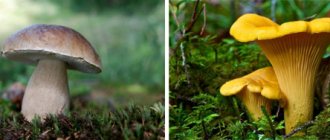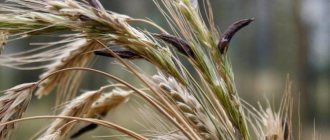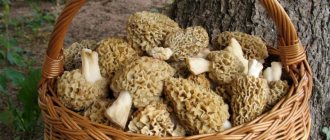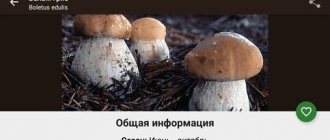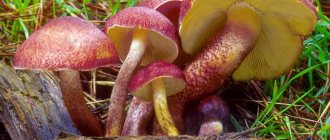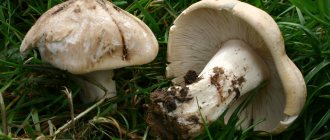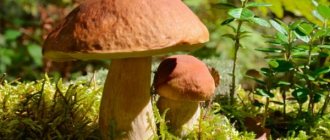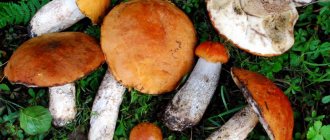Being a mushroom picker is quite an interesting hobby, which involves a forest adventure and walks in the fresh air. But in order for this activity not to cause harm, you need to have a good understanding of mushrooms in order to easily identify edible ones.
There are a huge number of edible species. They have a special aroma and taste. Many of the representatives are considered delicacies, and finding them is a great success.
Mushrooms allowed for consumption are divided into classes, taking into account their taste and nutritional value. Many are incredibly valuable due to the large amount of nutrients they contain.
Mushroom “meat” requires the presence of useful substances such as proteins, carbohydrates, and is also rich in vitamins and minerals. It also contains enzymes that affect the digestibility and functioning of the digestive system. Champignons, which are considered the most consumed by humans, exhibit especially good properties.
Clustering of edible mushrooms implies the presence of the rarest specimens, which are not so easy to find. Finding a rare mushroom that has little nutritional value is still considered a great joy for mushroom hunters.
Here you can see a list of the most famous edible mushrooms that are of particular value to mushroom pickers. However, it is necessary to clearly know the distinctive features of the species so as not to confuse them with inedible ones.
Polish mushroom
Belongs to the boletus species. Previously, it was imported to Russian markets from Poland. This is where the name came from. It is considered a valuable product. It is boiled, fried, dried.
Appearance similar to porcini mushroom. At the beginning of growth, the cap is wrapped. It unfolds when the wearer grows to approximately 12 cm.
Rarely found in nature. Grows in acidic soils in areas with coniferous forests. Loves beech, oak and chestnut. Found in lowlands, foothills, and at the foot of trees.
Autumn honey fungus
Can be used in any form. The structure of the product is dense (it needs to be boiled for a long time) with a pronounced mushroom aroma, but it’s not for everyone.
The cap is first convex, then expanded, 2–15 cm in diameter. The color is sandy-orange, brown. Towards the center the color becomes brighter. There are small scales along the edges. The pulp is whitish.
Autumn honey fungus is a parasitic mushroom. It grows in a friendly family on trees and stumps. Prefers mixed forests consisting of birches, aspens, oaks and pines.
Edible raincoat
Edible mushroom from the champignon genus. Suitable for any culinary dishes. It has a pronounced mushroom taste. The mushroom is collected at the beginning of its growth. As it grows, it becomes very tough.
The color of the mushroom is light, almost white. Has brown inclusions (scales). As they approach the center of the cap, the scales become darker. The fruit part is 2–5 cm in diameter.
Grows in coniferous and mixed forests. Prefers wet (rainy) weather. Ripening time: early summer / late autumn.
Ringed cap
It is predominantly distributed in Europe. He has many poisonous counterparts. Grows from July to September in damp forest areas. More often found near blackberry bushes and under spruce trees.
The mushroom's cap is similar to a cap, up to 12 cm in size. The color ranges from a yellowish tint to brown. When cut, white flesh is visible. When exposed to oxygen, it quickly turns yellow.
Kozlyak
An edible representative of the boletus genus. It is also called reshetnik, flywheel. Delicious, slightly slippery mushroom. It is easy to confuse the goat mushroom with its inedible brother, the pepper mushroom.
The cap is 3–12 cm, cushion-shaped, spongy, porous, shiny. It feels sticky and smooth to the touch. Color - light brown, brown.
Loves coniferous forests and acidic soils. Often grows in symbiosis with pine. There are single “tenants” and entire families.
Porcini
One of the most valuable noble mushrooms. Other names: boletus, yolk. The mushroom is edible in any form. It has a rich, dense taste.
The stem of the mushroom is thick, dense, and beige-white in color. The cap is brown, straightened, up to 50 cm in diameter.
Peak collection occurs in late spring and early summer. But it is also found in the fall (in warm, humid weather). Loves deciduous and coniferous forests, often growing near moss and lichen. Prefers loamy soil and sandstones. Distributed throughout Russia.
Common dubovik
An edible type of boletus. Valuable mushroom. Similar in appearance to its white counterpart. Grows mainly in oak forests. Sometimes found in coniferous and mixed forests.
Oak wood is collected throughout the summer and early autumn. The best time is after the rain. The cap of the mushroom is large - up to 20 cm, and shaped like a dome. When it grows, it opens up and becomes like a pillow. The surface is matte, velvety. Color - gray-brown.
Does not lose elasticity during cooking. Has a delicate mushroom aroma.
Bruise
Edible but unusual mushroom. In appearance it is beige, but when pressed or cut it begins to acquire a bright blue color. The blue substance secreted by the fungus is safe for humans.
The cap is convex, evenly colored in a sandy shade. There is a thickening on the bottom of the leg. The pulp is brittle and loose.
Grows alone in sandy soil. Loves oak groves or conifers. The collection begins in mid-summer and continues until the end of the warm season. The representative is listed in the Red Book.
boletus
A beautiful, edible mushroom. Has a pronounced mushroom aroma. Suitable for any dish.
The lumpy, matte cap is represented by a hemisphere with a diameter of 5–15 cm. The color is gray-light brown, darkening towards the center. May be confused with gall fungus. It is not poisonous, but very bitter.
Boletus mushrooms are collected near deciduous trees. They grow on the edges and in lowlands.
Gray row
An edible mushroom with a bright taste. It has other names - serushka, pine tree. It is eaten after heat treatment (after boiling). Dense mushroom base without bitterness.
Grows in symbiosis with pine trees. Loves sandy soil under pine and mixed forests. Does not disdain old plantings.
The hat is average - 4–12 cm. Sometimes it grows up to 20 cm. Color - gray with a slight purple tint.
Common chanterelle
Edible bright orange mushroom. It is also called “cockerel”. Difficult to confuse with other specimens. Initially, the cap has a slight convexity, then becomes irregular in shape and curls into a funnel. Diameter - 4–7 cm.
The taste is mushroom, dense. The consistency of the fruiting body is fleshy and compacted. During heat treatment, it loses a little color, but retains moisture.
It grows in groups from June to November in coniferous and mixed forests. Often found near moss and in needles.
Lilac-legged rower
An edible mushroom from the row family. They are among the good mushrooms, that is, they are collected and eaten. The mushroom got its name because of the corresponding color of its stem.
The cap is white with a slight purple tint (6–15 cm), the leg is purple. Sometimes there are giants up to 25 cm.
A meaty, dense mushroom. The taste is sweetish, with fruity notes. No strong mushroom taste. Grows in summer and autumn in meadows and forests.
Oiler yellow-brown
Tubular, edible representative of butter. Other names: swamp grass, pestle. Prefers symbiosis with pine, but is also found in mixed forests. Grows on sandstone and among fallen pine needles.
The cap is small - 3–10 cm in diameter. Flat shape. Color - brown-cream.
The mushroom is fried, boiled, marinated and salted. The quality of the product is low, but many value it for its specific, oily taste.
Golden scale
A bright, easily recognizable mushroom. Grows in groups. Loves living but fallen trees.
Conditionally edible mushroom. It has an incomparable, slightly sweet taste. Experienced mushroom pickers collect it, heat it and eat it. However, many people complain of stomach pain after consuming the product.
The hat is shiny. It is bright orange with dark spots. The shape resembles a convex bell. Diameter - 5–10 cm.
Yellow hedgehog
Often called the chanterelle's cousin. Has high taste qualities. Easy to prepare - no need to boil or soak.
Mushroom specimens are reddish in color with a wavy cap up to 15 cm in diameter. There are small spines under the cap.
The representative grows in humid forests (mixed, deciduous, coniferous). Prefers to grow in groups.
Variegated umbrella
Edible, very tasty mushroom. But only experienced mushroom pickers collect it, as it can be confused with its poisonous counterparts - fly agarics.
The cap is initially ovoid, but as it grows it opens up and becomes huge. Some specimens grow up to 50 cm.
Grows on lawns, forest edges, paths. Loves oaks, pines and other coniferous trees.
Amanita pearl
An edible mushroom distributed throughout the northern hemisphere. Collection occurs from spring to late autumn. There are single specimens, but more often the mushrooms settle in groups. Loves clearings and light areas in mixed forests.
The cap is 5–15 cm, yellowish-cream, brighter in the center. The pulp is brittle (turns pink when cut, then turns red), without much taste. The mushroom aroma is subtle.
Green moss
Famous edible mushroom. Grows under broad-leaved trees (likes birch and willow). Moss mushrooms are harvested in the autumn - from August to November.
The hat is brown (up to 8 cm), matte. The leg is yellowish or greenish. The sponginess is porous, yellow.
Volnushka white
Conditionally edible, not very tasty mushroom. Commonly called whitefish. Accordingly, it has a white color and furry scales on the cap (its diameter is up to 6 cm). When cooking, the volushka is soaked and boiled several times.
The mushroom grows next to birch trees. The representative is most often collected by Russian mushroom pickers. In Europe it is ignored.
Classification of mushrooms
In total, there are about 14,000 species of mushrooms, which, according to the criterion of edibility, are divided into three groups:
- edible - representatives of the kingdom that are suitable for consumption even without special heat treatment, that is, fresh or dried;
- conditionally edible - mushrooms that can be eaten only after cooking; they are soaked in water and then boiled up to 2-3 times;
- inedible mushrooms are poisonous.
It is important for a mushroom picker to learn how to accurately determine whether a species belongs to a certain classification.
Signs
Edible mushrooms are mushrooms that do not require special processing and can be cooked and eaten immediately. Edible mushrooms do not contain any toxic substances that can harm the body; they are absolutely safe for humans.
The nutritional value of edible mushrooms falls into four categories, from high-grade to low-grade mushrooms.
In order to distinguish edible mushrooms from inedible ones, you need to know some common distinguishing features:
- edible mushrooms do not have a specific pungent odor;
- the color of edible mushrooms is less bright and catchy;
- edible mushrooms usually do not change color after the cap is cut or broken;
- the flesh may darken when cooked or broken;
- In edible mushrooms, the plates are attached to the stem more firmly than in inedible ones.
All these signs are conditional and do not provide an exact guarantee that the mushroom is edible.
The video clearly shows how to distinguish edible mushrooms from poisonous ones using the example of the most common mushrooms. It also tells you what to do in case of poisoning:
Edible mushrooms
Edible mushrooms are mushrooms that are completely safe for humans and can be eaten raw, dried or boiled. They do not contain toxic substances that can harm health. Edible mushrooms have a pleasant aroma and good taste.
Porcini
White mushroom
White mushroom or boletus is one of the most common edible species. It is distinguished by a light shade that does not change even after heat treatment.
Appearance Features:
- the cap is brownish-brown in color, up to 8-30 cm in diameter;
- the pulp is juicy, dense, fleshy, white;
- barrel-shaped leg up to 13 cm in height.
Porcini mushrooms grow on all continents except Australia and Antarctica. Most often they can be seen in deciduous, mixed and coniferous forests. Depending on the region, boletus mushrooms appear from late September to November.
boletus
Boletus
The favorite place for boletus to grow is forest edges and wet lowlands, near birch and poplar trees. Some species are found in coniferous forests and swampy areas.
Appearance Features:
- a hemispherical cap, up to 6-15 cm in size;
- the color of the cap is grayish-brown or reddish-brown;
- the leg is thin, narrowed towards the top;
- leg diameter - from 2 to 3.5 cm, height up to 10-15 cm.
The pulp is white, dense, but over time it becomes grayish and loose. You can harvest boletus from the end of May until the first frost.
Autumn honey fungus
Autumn honey fungus
A distinctive feature of autumn honey fungus is its dense pulp, so they require long-term heat treatment. As mushrooms age, they become tougher and more fibrous, which is why they are most often used for drying.
The caps of honey mushrooms are convex, gradually becoming flatter or bending upward. Their diameter ranges from 3 to 16 cm, and their color can range from brown-yellow to bright orange. The pulp is light cream or white, the plates are snow-white.
You can go for autumn honey mushrooms from the second half of August until November.
Boletus
Boletus
Boletuses can be recognized by their dense, stocky stem, fleshy flesh and brightly colored cap. Depending on the type, the diameter of the hemispherical cap can be 6-25 cm. Over time, it becomes more convex.
The leg is club-shaped, up to 20-23 cm high. It is covered with small scales of black or dark brown color.
Boletuses prefer deciduous, mixed forests, the sides of forest or steppe roads, and shady thickets. Depending on the type, mushrooms ripen from the second half of September to the end of October.
Common chanterelle
Common Chanterelle
A characteristic feature of the common Chanterelle is its bright orange color. Young mushrooms have a flat cap; as they grow older, a funnel appears in its center, and it takes on an irregular shape.
The edging is folded and wavy, the diameter reaches 5-8 cm. The flesh is juicy and elastic, of a rich orange-yellow hue. The stem of the mushroom is elastic and dense, narrowed at the bottom, 5-8 cm long.
Common chanterelle is found in mixed, deciduous and coniferous forests and can be collected from early July to November.
Oiler
Oiler
The oiler is distinguished by the mucous surface of the cap, colored in a rich yellow, brown or purple hue. It is usually small in size - up to 10-13 cm.
The cap can be flat or convex, it is covered with mucus. The pulp is white and soft, the stem is solid, up to 12-15 cm long.
Most often, boletus can be found in coniferous forests, under spruce and pine trees, in sunny meadows and clearings. The first harvest is harvested in June, the next time you can go for mushrooms in the second half of August or early September.
White truffle
White truffle
Under natural conditions, white truffle grows exclusively on the roots of certain trees - poplar, beech, oak, hazel. For industrial use, this rare mushroom is grown on special farms. The largest part of truffles grows in Italy, Croatia and France.
The mushroom has a round shape that resembles a dirty stone with a brown surface.
The pulp is marbled, grayish. The size of a large truffle does not exceed 3-5 cm. Interesting fact : truffles are considered the most expensive mushrooms in the world - the price for 1 kg of the delicacy can reach $8,000.
Kozlyak
Kozlyak
Kozlyak or moss fly is distributed throughout Eurasia. It ripens in the second half of August or early September.
Interesting: Butter
